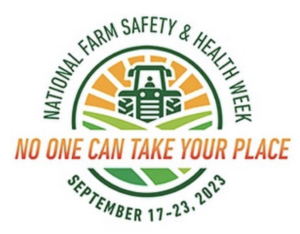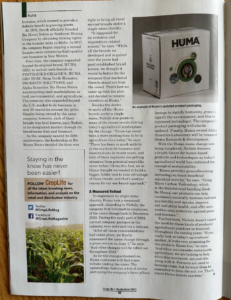Everyone remembers where they were on September 11, 2001. One of my most vivid memories was the week after. I was farming with my dad at the time. He had just started cutting soybeans in a field owned by my wife’s family, situated next to Interstate 74 in western Illinois. I was driving to the field to meet him and take a load into the elevator, but I couldn’t help but hear a steady cadence of horns blasting from the cars and trucks traveling along the adjacent interstate. Then I noticed several hands waving at him, from those passersby. As I drove closer to the combine, I felt goosebumps, then a sense of pride rushed over me. Instantly, I knew what all the fuss was about. Dad had affixed an American flag to the grain platform of our combine. And a brisk autumn wind waved Old Glory across the scenic backdrop of the family farm. This was truly a vision of Americana. At the perfect time. Today, you see a fair number of farmers displaying the Stars & Stripes on their equipment, which always brings a smile to my face and a memory to my heart.
It’s National Farm Safety & Health Week. For me, this hits way too close to home. My grandfather never saw me or my mother. He lost his eyesight when an anhydrous hose burst and sprayed gas in his eyes. He spent the next 30+ years of his life blind. My father-in-law had his pelvis shattered when a grain platform fell on him as he was working underneath, effectively ending his farming career. Both incidents could have been avoided with proper equipment and protocols. But that’s often easier said than done. Fatigue, stress and being in a rush are major contributors, especially during this busy time of year. Talk to any farm family, and they’ll have a personal tragedy to share. That’s because the world’s greatest profession is also the most dangerous. Over 250 agricultural workers suffer injuries or death every day. Given their working conditions, it’s no wonder why. Farmers are in constant contact with heavy machinery and are exposed to harsh elements. The most common injuries occur from overturning tractors and equipment, falls from elevated places, entanglements with PTO shafts and tools, suffocation, and burns. Autumn is full of perilous predicaments, including grain bin entrapments. And tragedy isn’t limited to what happens on the farm. Roadways present major risks, as motorists often become impatient behind equipment traveling less than 25 mph. The bottom line is safety must be a consistent mindset. Quick, daily safety meetings can help prevent many tragic events from occurring. So can proper training, to educate new farm workers and refresh seasoned pros who often take situations for granted. That’s why I’m especially proud to have helped my friends at Agricenter International develop the Farm Safe program, which includes a series on-line, in-person and virtual courses. I encourage everyone involved in agriculture to check them out. At Huma, we are fortunate to have an experienced director of safety, Kevin Rivera, train and promote safety throughout our organization.
The current print edition of CropLife magazine features a great two-page story on our Huma brand launch.
Fall officially arrives this weekend. And that means Halloween is upon us. A staple of the spooky season is the KitKat bar. Admit it, how many of you parents heist those tasty KitKat bars from your kid’s Trick-or-Treat bags? KitKat is one of the most popular candy bars in the world – 650 of those crunchy bars are consumed every second of every day. Now, KitKats may play a role in the #soilhealth and #regenerativeagriculture movement. Nestle is partnering with Cargill to test the use of cocoa shells from their KitKat-making confectionary in York, UK, as a low-carbon fertilizer for wheat in a circular system. The cocoa shells are processed and pelletized by UK-based CCm Technologies. These trials speak to the lengths that CPGs are going to create more sustainable supply chains, as they are looking at every angle. Nestle has pledged to source 50% of its key ingredients from regenerative ag farming systems by 2030. The production and use of conventional fertilizer accounts for 5% global GHG emissions and more than half of the carbon footprint of wheat grown in the UK is related to fertilizer use. Would the use of humic products, and possibly X-Tend, give an added boost to the performance and sustainability of this unique fertilizer product?
Related Posts

Open, With Care: A Video Message From Bio Huma Netics
BHN Operation Team Message from BHN_Vimeo on Vimeo. At Bio Huma Netics, Inc., our Operations Team realizes the incredible challenges that are in the world today, and we are doing everything in our power to better serve you. From the start of the crises, our Team has focused on keeping our employees, customers, families,

This Week in Ag #55
While farmer sentiment may be down, their appetite for new information is not. Initial estimates had last week’s Commodity Classic drawing record crowds, with projections of 11,000 attending the event in Houston.

Land-Applied Sewage: Do Farmers Benefit from Recycled Sewage?
While controversial among activists and consumers, land application of septic and sewage sludge is not a new practice. Farmers have been land-applying raw sewage––at one time called "Night Soil"––to fields and crops for centuries.




